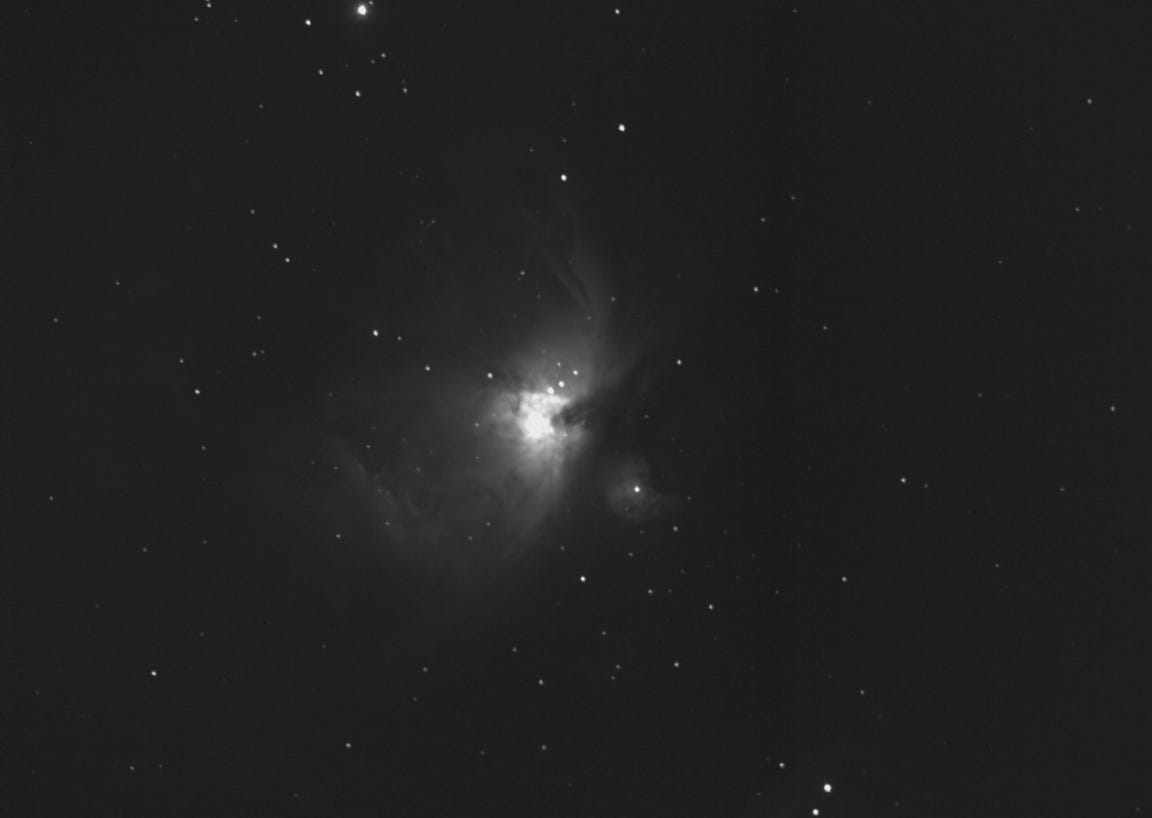M 42 continued
More data on M42 were taken in January 2017 and in 2019. Pictures on this page also show the progress in image processing - PixInsight vs. fitswork/GIMP - in particular when data from 2014 and 2017 are combined in the analysis. Recently, a picture using the monochrome ASI1600mm pro was added.

M42, 21 January 2017, Noordwijk, William Optics 110 mm APO FLT f/7, UV-IR, UHC filter, Canon EOS 600D, 800 ISO, 580 sec, fitswork


M 42, Noordwijk (NL), combination of data from 3 February 2014 and 21 January 2017, William Optics 110 mm APO FLT f/7, Canon EOS 600D, UV-IR, UHC filter, 400 ISO/800 ISO, f = 770 mm, 761 sec, Image processing with fitswork/GIMP (left panel) and with PixInsight V 1.8.8-5 (right panel)


M 42, Vorst (D), 25 February 2019, William Optics 110 mm APO FLT f/7, Canon EOS 600D, UV-IR, Hbeta filter (486nm, ±4,3 nm) ,
800 ISO, f = 770 mm, 540 sec,. Image processing with fitswork/GIMP (top panel) and with PixInsight (bottom panel.

Orion, M42, Vorst (D), 30 Dec 2019, Canon EF 70-200 mm f/4 L USM telelens, Canon EOS 600D, 800 ISO, UV-IR, UHC filter, f = 131 mm, stack of 55 exposures, each 30 sec, 1650 sec, PixInsight

Orion nebula M42, 11 February 2022, Kempen, William Optics 110 mm APO FLT f/7,
ASI1600mm pro, L(UV-IR cut), 660 s (66 x 10 s), No auto-guiding, gain 139, T: -10C, Image processing with PixInsight V 1.8.9
Finally, I combined (using the Mosaic process within PixInsight) to combine the Canon EOS 600D-DSLR images from 2014 and 2017 with the ASI1600mm pro (L-filter) data from 2022. The Canon data were converted from RGB to Grayscale, cropped and background corrected, then combined with the ASI monochrome data. Both detectors have comparable pixel size: 4.5 micron and 3.8 micron. The resulting mosaic is shown below.

Orion nebula M42, 3 February 2014, Noordwijk (NL) + 21 January 2017, Vorst (D) + 11 February 2022, Kempen (D), William Optics 110 mm APO FLT f/7, Canon EOS 600D, UHC,
ASI1600mm pro, L(UV-IR cut), 181 s + 580 s + 660 s, partial auto-guiding, gain 139, T: -10C, Image processing with PixInsight V 1.8.9
Combination of the monochromatic ASI1600 mm pro camera with the Canon EF Telelens and narrowband filters offer a special view on the large hydrogen structure called “Barnard Loop”. The picture below was obtained using a H-alpha narrowband filter, with data from a narrow O[III]-filter as “background” data (as the Barnard Loop emission is almost entirely in H-alpha). The three “belt stars” are clearly visible, as is the Orion nebula M42 (near the bottom) and the region including the horsehead nebula, near right ascension/declination 5h 40m, -3.

Orion Belt Stars
Horsehead Nebula
Orion Nebula M 42
Barnard Loop in constellation Orion, with M42 and horsehead nebula. 12 December 2022, Kempen, Canon EF 70-200 mm f/4 L USM telelens, f = 70 mm, ASI1600mm pro, H-alpha (3600 s),
O[III] (3600 s), auto-guiding, gain 139, T: -10C, Image processing with PixInsight V 1.8.9